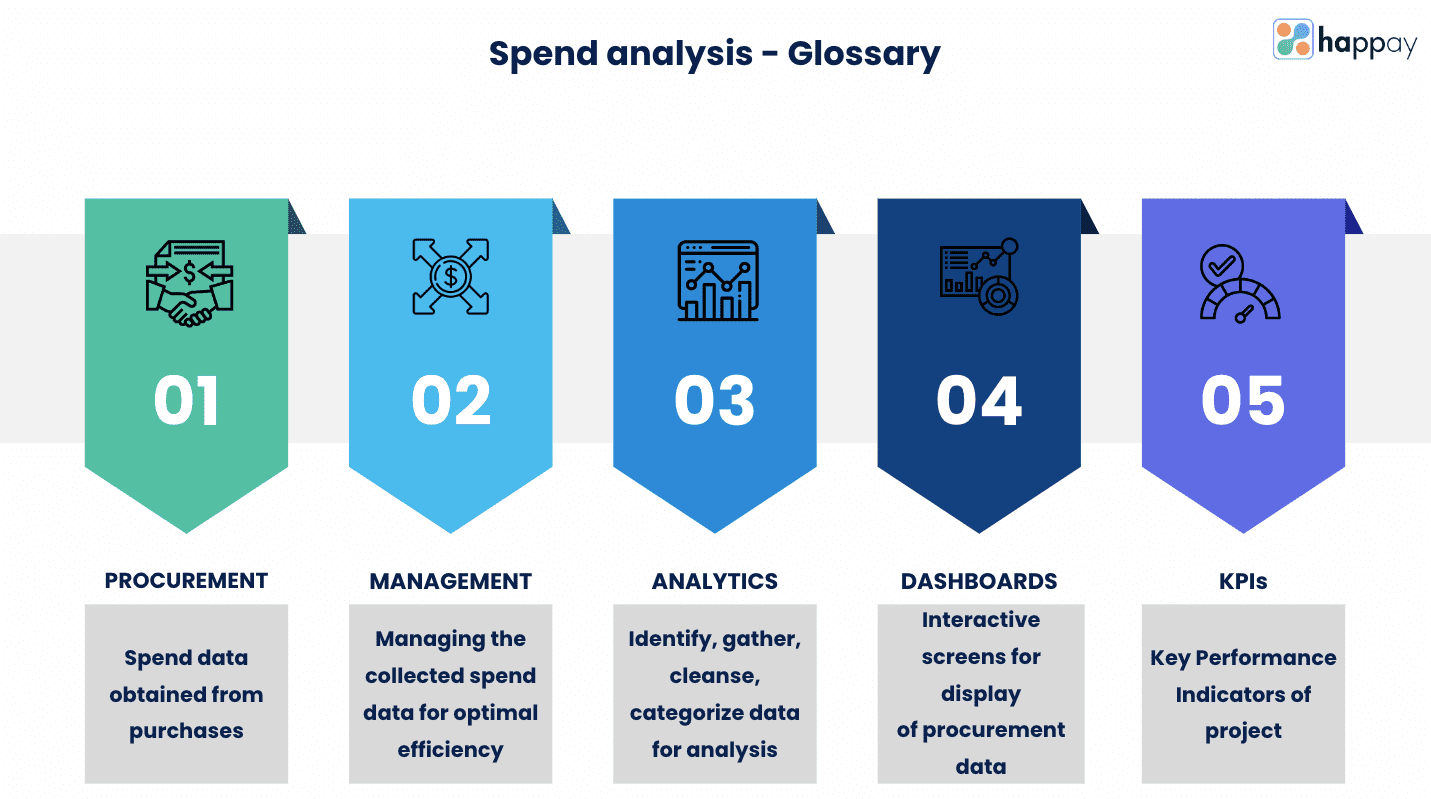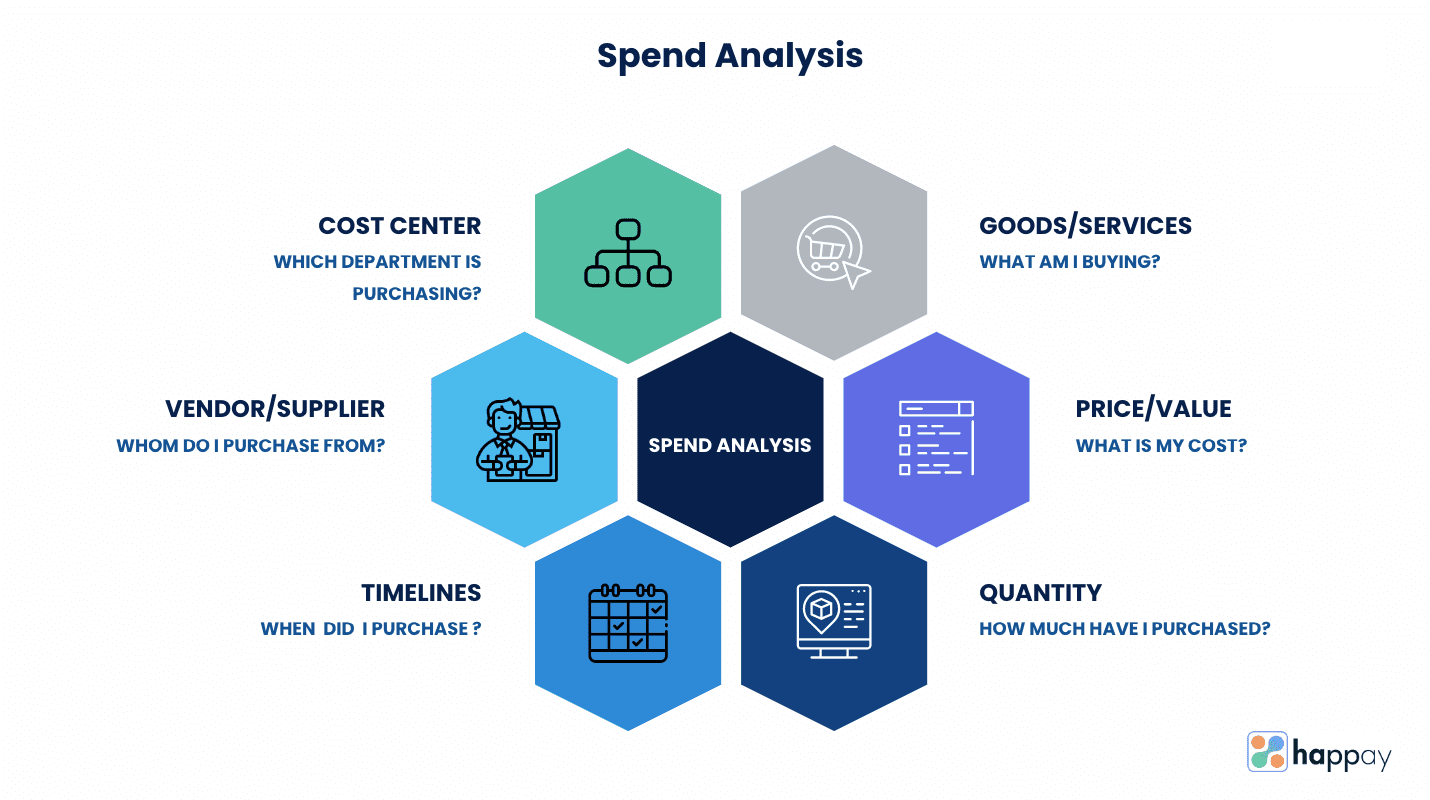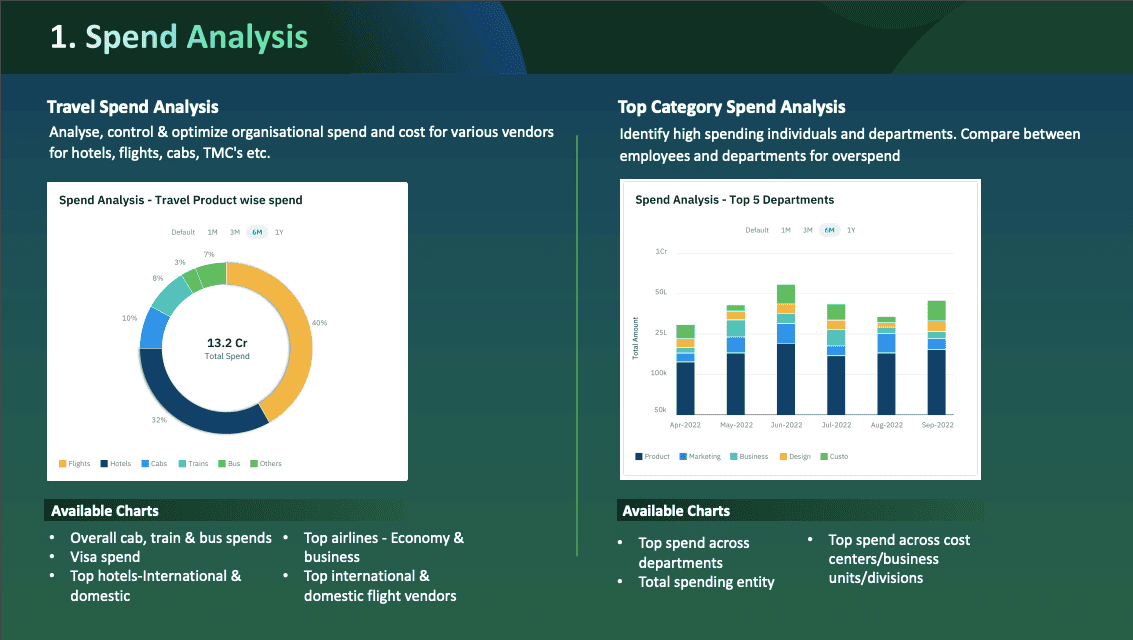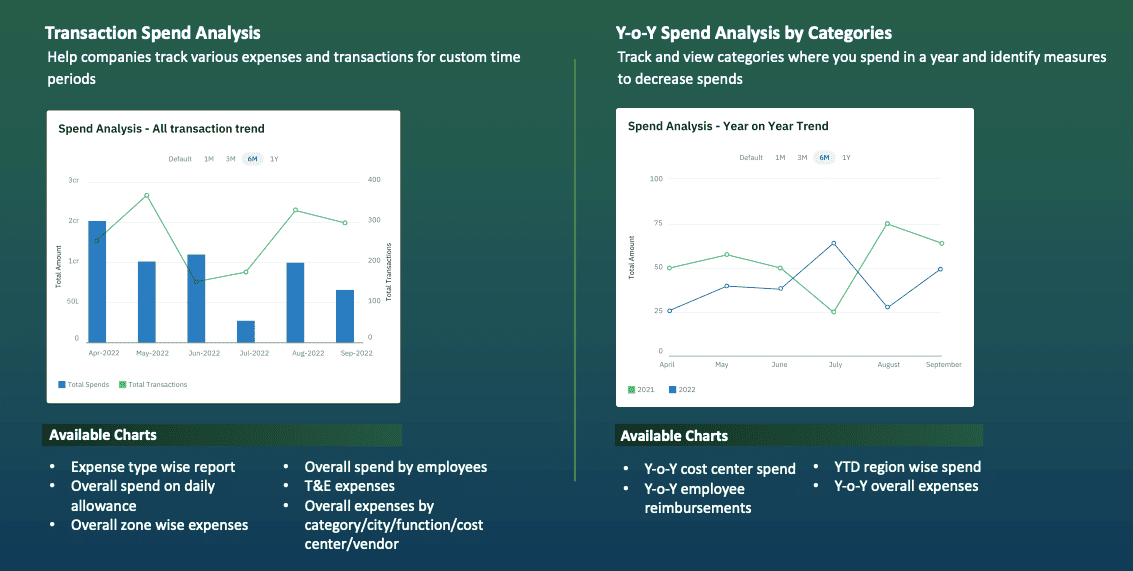Spend analysis
“What gets measured gets managed”- Peter Drucker
APQC’s Open Standards Benchmarking in procurement has found that organizations with spend analysis programs/systems performed better than the rest in several metrics. For instance, some metrics were procurement cycle per purchase order, cost of the process, percentage of purchase orders approved electronically, and several others.
To understand why CFOs need spend analysis, read on as we delve deeper into the subject.
What is spend analysis?
Spend analysis captures, categorizes, and analyzes the spend (or expense) data. The goal is to understand where the business is spending and whether it is doing so efficiently.
Spend management, on the other hand, is about gathering, tracking, analyzing, and controlling expenses or spending across business units. You can protect the business’s bottom line with spend management.
Therefore, spend analysis is just one part of spend management.
Spend analysis example
Let us assume that a manufacturing company orders parts from a vendor. A spend analysis will group suppliers by expense categories and any others that may be relevant. Any direct spend offers invaluable insight into the expense, payment terms, inventory quantity, price variations, patterns, and how you can control/reduce expenses.
In the above case, the company can identify saving opportunities and take the initiative to negotiate better terms with suppliers.
Key terms in spend analysis

1. Spend analysis and procurement
When you purchase goods and services from external suppliers, there is a good deal of spend data (procurement information). You can analyze the data in several ways to understand the procurement process. Generally, a CPO or the chief procurement officer uses KPIs to measure the procurement process’s effectiveness.
2. Spend data management
You must manage the spend data or the information from sourcing or procurement to optimize the organization’s efficiency while maximizing your bottom line. So, the practice you follow is spend data management, whether it is lowering financial risks, reducing costs, or boosting supplier relationships.
3. Spend analytics
Spend analytics is when you identify, gather, clean, categorize/group, and analyze data you derive from your business’s various sourcing and procurement functions.
4. Dashboards
In this case, spend analytics dashboards are interactive screens that give you an extensive view of the organization’s activities in procurement or sourcing. A dashboard works like a ticker at the bottom of your screen, giving you a quick look at the most relevant information. So, dashboards help to view the number of suppliers and their value for your business.
5. KPIs
KPIs are Key Performance Indicators that give you specific, measurable values indicating your project or activity’s success.
Also, Read: A Guide to Expense Management
Types of procurement spend analysis
Spend analysis can help businesses understand the nature of expenses and address their sourcing strategies and other areas that need more control. There are many types of spend analysis that companies may use. Here are some of those
1. Vendor spend analysis
Vendor spend analysis studies the funds used on services or products needed for the business. So, evaluating the spend on vendors or suppliers that support business operations is at the core of this kind of analysis. The results of this analysis may form the basis for supplier management and improve vendor relationships.
An example: Consistent vendor evaluations during a period lead to the conclusion that by signing up for a higher subscription, the business will benefit from better product quality and save money in the long run.
2. Tail spend analysis
Tail spend refers to small or insignificant expenses that a business incurs. Generally, such expenses are not within a contract and do not recur often. Overall, such expenses constitute about 20% of an organization’s total expenses. While such direct or indirect spend may seem insignificant, controlling such costs through regular tracking and analysis can lead to potential savings.
An Example: A business was spending small amounts purchasing certain stationary items and office supplies. On looking closely, the company could negotiate with an existing vendor to deliver the same things at a reduced cost saving the business money and effort.
3. Item spend analysis
An item spend analysis categorizes the expenses based on the department that uses the article. This sort of analysis focuses on individual items. The goal is to understand and control leakages. The results can prompt organizations toward better strategic sourcing.
An Example: Businesses can analyze the purchase of notepads and other books as they classify the expense based on the number of books required by the various departments in the business.
4. Category spend analysis
Resource allocation is an important concern for procurement teams and the decision-makers of a business. Business leaders can identify the areas that create the most value for the company by categorizing the spend into segments while prioritizing the transactions. This information further feeds the next stage, which is to allocate resources according to priority.
An example: When a business decides to market its services or product aggressively, expenses to support that decision become a priority.
5. Payment term-based spend analysis
Depending on payment policies and procedures followed by the business, the payment-term-based spend analysis may suggest a different approach. Evaluating the current payment processes may lead to understanding how to change them to benefit the company.
An example: by analyzing vendor contracts, you may learn that the current process costs you more. By renegotiating the contract to include an early payment plan, your business may spend less on such agreements.
6. Contract-based spend analysis
This analysis focuses on the business’s contracts, efficacy, and profitability. Contract-based spend analysis studies the arrangements to ensure that vendors, suppliers, and other parties comply with the agreement.
An example: A close study of the vendor contracts tells the business that vendors are taking advantage of a small loophole in the cycle times that allows them to send their invoices for payments early. A slight change in the agreement can fix this loophole, thanks to the analysis.
7. Maverick spend analysis
When you buy from suppliers or vendors outside the existing procurement policy, you do not benefit from the supplier discounts or specific terms and conditions you negotiated for the business. This is called maverick spend. Also called rogue spend, an analysis of such procurement cost will give you an idea of where you may need to negotiate or re-negotiate terms.
An example: The e-procurement department of a company gauges that certain engineers were sourcing products (available through the e-procurement system) from other vendors as they could negotiate better terms. Eventually, this was addressed adequately by getting to the bottom of the problem.
Quick Read: 4 Ways to Simplify Your Expense Approval System
What are the stages in spend analysis?
Spend analysis is unique to every business, and therefore, there is no one good way to do it all. However, the stages in the process will help you achieve results.
1. Set up objectives
Setting goals is the first stage where the business comes up with the goals and scope of such an analysis. As mentioned, the purposes of such spend analysis will ultimately depend on the company and its requirements.
2. Ascertain the source of data
You must collect data across the business units and departments. The data is like a foundation for the success of spend analysis. So, as soon as the project’s objectives are final, you must identify all the single sources for collating spend data.
3. Merging the data
Data that does not speak to each other well does not serve the purpose. So, it is essential to collate the data, so it makes sense. For instance, ensure the collected data is available in a standard format. It will ensure no inconsistencies or data errors as you organize the analysis.
4. Make the data usable
When data is collected and put together, it is essential to ensure it is usable. The analysis results depend entirely on the accuracy of the information you employ. Therefore, making the data usable must include an extensive effort to standardize it and make it error-free.
5. Compartmentalizing the data
It is one of the significant steps where the spend data is categorized cleanly into groupings that make sense to the business. For instance, you may label the spend data of suppliers based on purchase information, the frequency of purchases, payment details, and so on.
6. Analysis
Once the categorization is complete, it is time to make sense of the data. Key performance Indicators or KPIs are standards set by the business. The result of the spend analysis is compared against the KPIs to evaluate the deviations (if any). Another factor that affects the results is a detailed classification of the spend. So, ensure that the categorizations are exhaustive and extensive for maximum benefit. It is a cycle
As the objectives change, data sources improve, and classifications evolve, the spend analysis process advances. The dynamic nature of spend analysis ensures that the process continues. Insights uncovered by the process become the foundation of the following procedure.
Suggested Read: 10 Best Expense Management Software
Why does spend analysis matter?

Importance of spend analysis
While your marketing department spends resources on advertisements and brand awareness, your manufacturing department is sourcing critical parts for business continuity. Apart from this, your employees are on the move, clocking in business and travel expenses.
Do you match and scamper as you put-together numbers at the end of the month? Wouldn’t it be great to know how much resources are being spent, and on what with just a click of a button?
Suppose you are managing spend the traditional way. Then, you don’t have spend visibility and spend a significant amount of time and resources analyzing data (post-events).
On the other hand, legacy systems do not give you complete, flexible, and centralized access to data. It does not give you customized reports or insights based on collected data.
Advanced spend analysis, data management, and procurement insights are hallmarks of a well-designed expense management system. Such spend analysis software systems eliminate risks while offering insights to control costs and boost growth.
Here are the main reasons to take up spend analysis.
- At its most basic level, spend analysis helps you to change raw data into usable information.
- Deep insights into the procurement process helps
- Identify cost-reducing opportunities
- Manage and improve supplier performance and risk
- Streamline procurement workflows
- Pinpoint challenges and problems in the process (unauthorized spending)
- Budget and forecast spend accurately
Also, Read: 10 Best Spend Management Software
Sources of Spend Analysis
Since the value and accuracy of the spend analysis depend on spending data, you must ensure that your data is clean (error-free), reliable, and reasonably accurate. Therefore, you must gather the data from all sources available to your business.
Here’s a look at the sources of spend data.
1. ERP Systems
Enterprise Resource Planning Systems allow for integrated management of the core business functions through software and technology.
For instance, businesses use numerous software technologies to manage and coordinate everyday operations such as purchases, sales, contract-based obligations, supply chain operations, project management, and accounting. ERP systems are an excellent repository of usable data, perfect for spend analysis.
2. Spend Analytics Software Systems
Without automation, spend analysis can be time-consuming and tedious. Software systems find spending patterns, collate data and arrange them into meaningful reports, and customise your data, so you get what you need for more intelligent business decision-making. As a source, such systems are precious as the error rate is almost negligible.
3. Purchase Orders
Purchase orders offer a ton of information regarding the purchases or sales of a business. The purchase orders give details such as the price of a product or service, date of payment, contractual obligations, etc.
As a seller, the invoices also give out important information. As a data source, purchase orders and invoices can help businesses zero in on how the firm performs in terms of the contract, sales, purchases, and so on.
4. Accounting Books/Systems
The three main accounting books or records that could be reliable sources for spending analysis are the profit and loss accounts, the balance sheet, and the cash flow statements.
These records provide hard and accurate facts that can improve the accuracy of the spend analysis. Since all business transactions (revenue, expenses, budgets, cash flow, etc.) find a place in these books, they make for a dependable source.
5. External Data
External data must be an essential data source for spend analysis. Businesses can benefit immensely by using external data. Firstly, such external data can validate the accuracy of their reported numbers. Secondly, including external data (information from investors, lenders, vendors, or creditors) as a source will only enhance the value of the spend analysis results.
Benefits of spend analysis for your business
1. Brings transparency and spend visibility to your organization
Are you sure that all contracts due for cancellation have been closed? What if some contracts are still open and your organization is continuing to spend on supplies that you can do without?
Whether it is supplies, suppliers, products, or services, transparency in its procurement and the entire process is not only helpful but critical for informed and more accurate business decisions. Further, clarity and transparency allow you to identify and finalize a classification system for your expenses.
2. Helps improve overall efficiencies
Do you find that there are constant delays in supplies because departments seem to re-order too late?
A good spend analysis program can help identify inefficiencies in the procurement process. Understanding your process and analyzing the following data may help you gauge how quickly you run out of supplies and the ideal time required to refill an order.
On the other hand, you may realize that Vendor A may be able to supply quickly during the winter months, and Vendor B may do so better in the summer months. You can then work out a contract that suits you.
3. Helps to identify ways for cost reduction and control spend
According to APQC’s research in procurement, 70% of the participating organizations have begun a spend analysis program. Compared to organizations without a spend analysis program, procurement operations are far more efficient, and supplier relationships offer more value.
The above research also confirms that organizations (with a $5 billion revenue)with a spend analysis program would likely spend $8,500,000 in procurement processes. However, those without spend analysis will pay 9,500,000. That’s almost $11 million more!
4. Insights help to understand vendor value
How many vendors do you deal with, and in how many currencies? How much value do your vendors bring in? Without spend analysis in your business, can you tell exactly how much your vendors are worth?
Spend analysis allows you to analyze a whole bunch of things to understand the value of vendor relationships.
- For instance, can you find a less-expensive option than the present vendor?
- Another example is when the spend analysis helps you understand the lead time with the present supplier.
- Spend analysis also helps you understand the product’s value by looking at the number of damaged products you receive or the number of times you ask for a service of the product.
5. Helps to manage and control risk
There are many ways to manage business risk. Spend analysis can give you data on employee travel and expense. Where do they spend the most? Are they using recommended vendors? Or negotiate with new vendors for accommodations?
Similarly, you can assess the risk of dealing with vendors by understanding how many complaints have been raised against them and the resolution. Again, is their credit score? Or, what is the delivery time?
6. Aids vendor compliance
Spend analysis ensures that your vendor compliance improves. Data from such an analysis will tell you if the vendor is keeping to their end of the bargain. For instance, how long does the vendor take to deliver the products? When you place an order, you can compare these numbers to the agreement or the contract for deviations.
Also, Read: Strategic Procurement: Definition, Goals, and Process
6 reasons spend analysis projects fail
1. Data quality compromised
Organizations spend about 80% of their time cleaning up their data. If the quality of the data you use for analysis is poor, you cannot rely on the results. A simple example of such poor data quality is blank fields or spelling errors.
2. Improper or ambiguous goals
One of the biggest reasons that most spend analysis projects fail is when organizations set unrealistic goals or rush into the project without proper planning. Planning plays a vital role in ensuring that your project is successful. Even beginning the process with a small data set (but complete and error-free) is bound to give you good results.
3. Manual cleaning or categorizing of data
Even imagining classifying and categorizing the enormous quantities of data that organizations generate is bound to give anyone nightmares!
However, considering the value of such classification and the subsequent analysis, going down to the minutest detail is essential and critical. While the challenge may seem unsurmountable and no one solution will give you 100% results, an excellent place to begin would be to place checks and balances to identify and correct errors immediately.
Considering the volume of existing data multiplied by incoming data, manually classifying the data is futile. Spend analysis solutions can eliminate human errors and give accurate and reliable results.
4. Questionable skills for analysis
Spend analysis projects fail because you need to understand your organization’s needs better. Without appropriate spend analysis tools or systems to support such a project, the validity of the spend analysis becomes questionable.
While finding the right spend analysis software may present a challenge, spending time finding a solution that addresses your organization’s needs and concerns is completely worth it.
5. Validity and number of data sources
As mentioned earlier, you can source spend data from multiple sources such as ERP, general ledgers, accounts payable, etc. Since they all classify data individually, using several methods, extracting and analyzing the data can take time and effort.
Such incompatibility leads to inefficient leveraging of the sources. Only a centralized repository of your information can help you reap the benefits of spend analysis.
6. Assuming that spend analysis is done only once
Transforming the procurement process through spend analysis must be an evolving process that may be time-consuming but well worth the effort. So, if you approach it with the goal of doing it once, it is bound to fail.
Spend analysis is certainly not a one-time effort!
Also, Read: 10 Best Procurement Software
Tips to ace spend analysis
Now that you understand spend analysis well, let’s get down to business and see how you can ace it.
1. Detail classifications are critical
Your aim must be to improve category management. Categorizing everything at the item level enhances visibility. Item-level categorizations offer insights into suppliers, commodities, and other essential aspects of spend. Further, the minute details of all attributes lead to better comparisons and estimates.
Further, it is crucial to adopt a standard classification schema that the industry adopts. Standardization is a critical element that will help you to organize and correlate spend data for actionable insights.
2. Focus on finding an automated and permanent solution
The sheer volume and complexity of spend data in an organization must deter you from pursuing a manual and labor-intensive solution. Outsourcing and external service providers may offer a solution. However, the project will require hand-holding, and the success of the spend analysis will depend on external factors.
Focus on developing a system of checks and balances within your organization while investing in spend analysis software that will satisfy your requirements completely. Typically, such solutions capture data classification rules and attributes based on the entire range of your spend categories.
Another massive advantage of automation is the increased frequency of analyses, which prepares you for the dynamic business environment.
3. Identify and use all sources of expense
A comprehensive and accurate spend analysis is when you gather data from various sources. Your suppliers may have better data than you. Make sure you include these sources, too, for your analysis.
4. Collaboration with all stakeholders is critical
Collaboration between the departments in your organization is an absolute must. Making everyone responsible and accountable for results gives you a better chance at an accurate spend analysis.
5. Action
Ultimately, the entire spend analysis process can be labeled as a success only if the insights from such a process transform into strategies that will positively affect your organization. Well-executed spend analysis projects must translate into saving opportunities, cost control measures, better supplier relationships, etc.
Also, Read: How to Form a Successful Procurement Plan?
Automation with spend analysis software
Software that analyses businesses’ spend data using visualizations while presenting them in customized yet simple platforms (dashboards) is called automated spend analysis.
Dashboards collate spend data to offer intuitive information, spend metrics, KPIs (Key Performance Indicators), and other information to users. Spend analysis can identify trends, create time-series plots, and offer valuable insights for key stakeholders.
Spend analytics software like Happay’s offers custom dashboards customized and built to suit your business requirements.


Some of the advantages you can get with Happay.
- Happay ReconX gathers more than 40 data points from several sources into one accessible place (payment, booking, employee, ERP, Project, Vendor, Forex data).
- You can identify opportunities to reduce your spend and gain better predictability.
- Access to real-time MIS reports for group and entry-level data, all accessible in your Happay Dashboard.
Conclusion
Happay offers an exceptional spend analysis product that will give you complete visibility into your spend, while increasing efficiencies and savings across the board. If you want to understand how Happay can help you, schedule a demo with us by clicking here.
FAQs
While there are numerous steps to ensure your spend analysis is accurate, the first and most important stage is ensuring your data is uncontaminated and error-free.
A budget works like a guide for an organization to understand how many resources they have for expenses. On the other hand, spend analysis determines how and where they spend the allocated budget. Creating a budget happens initially, while spend analysis occurs when expenses are incurred, and the budget is used up.
The process of identifying, gathering, and classifying marketing data to understand and analyze the organization’s marketing spend is called spent analysis in marketing.
a) First, you begin by identifying all sources of your spend data
b) The next stage involved decontaminating your data
c) Arrange and organize your data centrally
d) The next stage involves categorizing your data
e) Automation can help provide quicker and more accurate reports at this stage.
f) Strategize based on insights



Discussion about this post